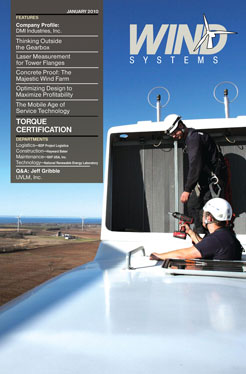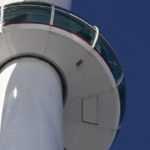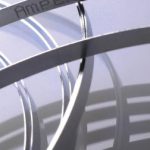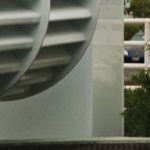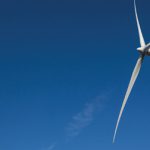As any wind professional knows, the towers supporting massive turbines are far more complicated than they might appear from the ground, requiring incredibly precise manufacturing techniques and practices. Made of rolled steel segments attached by flanges, these increasingly tall tubular structures demand flanges that meet very tight flatness and parallelism tolerances.
Manufacturing the flanges is difficult enough, but many have also found difficulty in accurately measuring the flatness or quality of the flange. Achieving geometrical correctness is made difficult by the manufacturing methods used. During the welding of the flange segments and storage of the sections, tension and/or stress can be induced. This stress can change the dimensional characteristics of the flange/segment, making it out-of-spec and therefore rejected. This condition then requires additional labor and machining to correct the problem, driving up costs and delaying the schedules. The ability to detect and ultimately correct these geometric features ensures a faster production schedule, better quality, and a trouble-free assembly as it was designed, along with happy customers. Up to now 19th century tools were used to measure flatness on these flanges, utilizing a straight edge or tight-wire and feeler gauge. This is no longer acceptable, and proper instrumentation is required. Thus began the search for new measuring methods and techniques to be able to combat these problems.
Based in Germany, Status Pro® has developed a new and unique laser system enabling geometrical measurement as required by the wind energy industry. The ultimate goal was to develop an easy-to-use yet highly precise measuring system, enabling the user to obtain the information needed quickly, accurately, and with excellent documentation. The result is a universal system capable of measuring a wide variety of geometrical features on many different components.
The System
The T330 laser transmitter essentially consists of a rotating laser-prism unit integrated into a sturdy housing. The laser produces a 360-degree “plane of light” instead of a dot. The functions of the rotating laser unit can be remotely controlled via infrared communication that is built into both the laser and the R310 receiver. In other words, the setup of the laser plane is achieved automatically.
With its 80mm range, the R310 receiver is the largest sensor in the industry. The measured readings will display the height of the laser plane using an onboard LED display, and it will also send the results to the DU310 handheld display unit via Bluetooth. Measurements are recorded as fast as you can move the receiver and push the button. As already mentioned, the flow of information is completely wireless, making cables a thing of the past and reducing the resulting downtime by providing real-time results on the handheld PC.
All the system components (Fig. 1) use either disposable batteries, rechargeable batteries, or AC power. There are various accessories that can be added to the system allowing the measurement of almost any geometric application required: precision leveling, flatness, straightness, parallelism, bores, and so on.
Laser Flange Measurement
Flanges are essentially joints, so they must be machined properly in order to avoid tension during or after coupling, and also to ensure water tightness of the coupling faces. Achieving geometrical correctness is made difficult due to the manufacturing method. During the welding of the flange segments together or during storing of the sections, tension and/or stress can be induced. The ability to detect and ultimately react to these dangers ensures a trouble-free service life. Many people have had to rely on straight edges and feeler gauges to accurately measure flatness on their flanges. This method is fine as long as the objects are smaller than the straight edge, but with segmented, chained, or overlapping measurements the problem of surface waviness arises. This created the need for modern measurement tools, methods, and techniques to be able to combat these problems in a fast and easy way. Using a rotating laser, it became possible to measure the entire flange against a constant reference; an ultra-flat plane of laser light (Fig. 2).
First, mount the laser directly on the flange or beside it using a tripod, allowing the laser beam rotation to effectively produce a laser plane. With a R310 receiver you are able to measure the distance between the flange surface and the laser plane very accurately.
Traditionally, the laser plane has been manually adjusted to parallel at three points on the flange, and those points become “zero.” This method is very time consuming and relies on the skill of the two people during the setup process. Manual calculations are also involved to achieve parallelism.
A preferred method is to simply allow the laser to rotate 360 degrees, thus producing an ultra-flat plane of laser light. This method is much quicker with the use of a PC and the appropriate flange flatness software. With modern systems this can be achieved onsite very quickly and in real time. Older systems measure first, then you have to transfer the data to a separate PC for evaluation, and then a report has to be generated.
Measurement Layout/Results
Status Pro’s goal is to make the measuring equipment simple to handle yet as precise as possible, and to ensure speedy measurements (Fig. 3). Simply set up the laser as described, scan all the points to be measured in any order, and record the results. The measurement of a flange with 104 holes takes around 25 minutes to complete, which includes the time it takes to set up the system. In the case of a measurement error, a single point can be remeasured at any time without having to repeat all of the previous readings. The results are directly displayed in 3D (Fig. 4), 2D (Fig. 5), or as a chart format.
Another feature of the program is a well-arranged measurement report in PDF format, and the data can be transferred as a CSV file into other types of software for further analysis if desired. Consequently, evaluation of the raw data is possible with most programs and applications.
An additional highlight of this system is “expandability.” In other words, with the aid of a second sensor, the system can be used to measure the parallelism of two flanges (Fig. 6). Hence, the flanges at both ends can be measured for evenness and parallelism with the appropriate documentation.
In addition to measuring flanges, the system is also able to level surfaces such as foundations and base plates. Utilizing the integrated “self-levelling” feature, you are able to measure objects in much the same way as you do a flange. Just push a button and the T330 laser levels itself within 0.025mm/meter. Then use the R310 receiver to scan and record the points to be measured. Using the LED display on the receiver makes a PC unnecessary. Measurements with spirit levels, cumbersome straight-edges, and tight wire and feeler gauges are a thing of the past. Propeller hub and the blade flanges can be measured in the same way, enabling detection of problems that could arise during the machining or assembly process.
Even quite complex arrangements of more than one object can be measured and documented thanks to the innovative software. Fig. 7 shows the measurement of the tower head assembly.
The base frame is a vital part of the tower, and it is also subject to twisting during the welding process. Locating and supporting surfaces (gearbox-to-generator) can be measured and documented very quickly. If twist or tension is identified in time, actions can be taken to prevent damage or problems during assembly, ultimately prolonging service life.



















